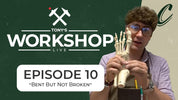
How Custom Orthotics Helped Ease Hallux Varus Foot Pain
, by Tony Chiappetta , 10 min reading time

, by Tony Chiappetta , 10 min reading time
Discover how custom orthotics helped relieve hallux varus and corn pain after surgery, using real techniques from Chiappetta Shoes’ Workshop Live.
When a woman came into Chiappetta Shoes, she’d been living with foot pain for decades. After a bunion surgery in the 1980s, her right foot had never been the same. The arch had collapsed, the big toe angled inward, and a painful corn had formed on the tip of the toe—making every step miserable.
Tony Chips, a Certified Pedorthist, knew this wasn’t going to be a simple insole fix. This was a classic—but complicated—case of hallux varus, made worse by tendon dysfunction and long-term wear on the joints.
In the video below, Tony walks through his full process—from evaluating the deformity to designing a custom orthotic solution that gave this patient relief, mobility, and a much more stable gait.
Hallux varus is a condition where the big toe drifts inward, away from the other toes. It’s often caused by:
Overcorrection during bunion surgery
Degenerative tendon issues (like posterior tibial tendon dysfunction)
Or structural foot collapse over time
In this case, the woman had all three:
A bunionectomy from the '80s had overcorrected her toe. Since then, her arch had collapsed, and her big toe curved sharply inward—creating a Z-shaped alignment. This deformity caused the foot to splay outward, the toe to press into the insole, and a corn to form at the tip from constant rubbing.
Surgery wasn't an option anymore , so the goal became clear: relieve pressure, restore alignment as much as possible, and make walking comfortable again.
Tony designed a fully custom orthotic setup, built around the unique needs of each foot.
The left foot had a fallen arch, but no deformity. Tony created a relatively simple orthotic to provide mild correction and structure for day-to-day comfort.
The right foot required a much more technical build:
Three layers of soft foam for shock absorption
Two structural layers (EVA and cork) to reinforce the arch and prevent further collapse
This five-layer foundation gave the foot a stable base while still protecting sensitive areas from impact.
After two weeks of wear, the left foot was doing fine—but the right foot was still struggling. So Tony added a few critical modifications:
Scaphoid Pad:
Placed under the arch to slow overpronation and give the midfoot extra support. A 55-durometer EVA was selected—soft enough to cushion, firm enough to correct.
Anatomical Metatarsal Pad:
Added to both feet for balance, but specifically on the right to offload pressure at the ball of the foot and help guide toe positioning.
Big Toe Cutout with Eco Cell Fill:
Tony carved out a relief zone beneath the corn on the big toe and filled it with ultra-soft, slow-recovery eco cell foam. This reduced friction and allowed the toe to move slightly without pressure.
These thoughtful adjustments transformed the orthotic from “helpful” to “life-changing.”
Many people assume surgery is the only fix for hallux varus—but that’s not always true, especially in long-term cases. Here's why custom orthotics for hallux varus are often the better choice:
They reduce pressure on sensitive areas (like corns or calluses)
They realign the foot gradually without forcing change
They accommodate deformities instead of trying to "correct" them all at once
They allow for pain-free movement in everyday shoes or sandals
And most importantly—they’re adjustable as your foot adapts
Tony’s patient didn’t need surgery. She needed a smartly designed, flexible orthotic that could reduce pressure, improve alignment, and protect her foot.
Every foot tells a different story. Don’t assume symmetry—customization is everything.
Material matters. EVA, cork, and eco cell all serve different functions in shock absorption and control.
Hallux varus requires accommodation—not forceful correction.
Pain relief starts with pressure relief. Strategic cutouts and soft fills can make all the difference.
Follow-up and iteration are essential. Orthotics should evolve based on how the patient feels after wearing them.
If you or someone you know is experiencing rigid feet pain, our certified pedorthic experts are here to help! We offer free foot assessments, make custom orthotics in-house, and provide free orthotic adjustments.


